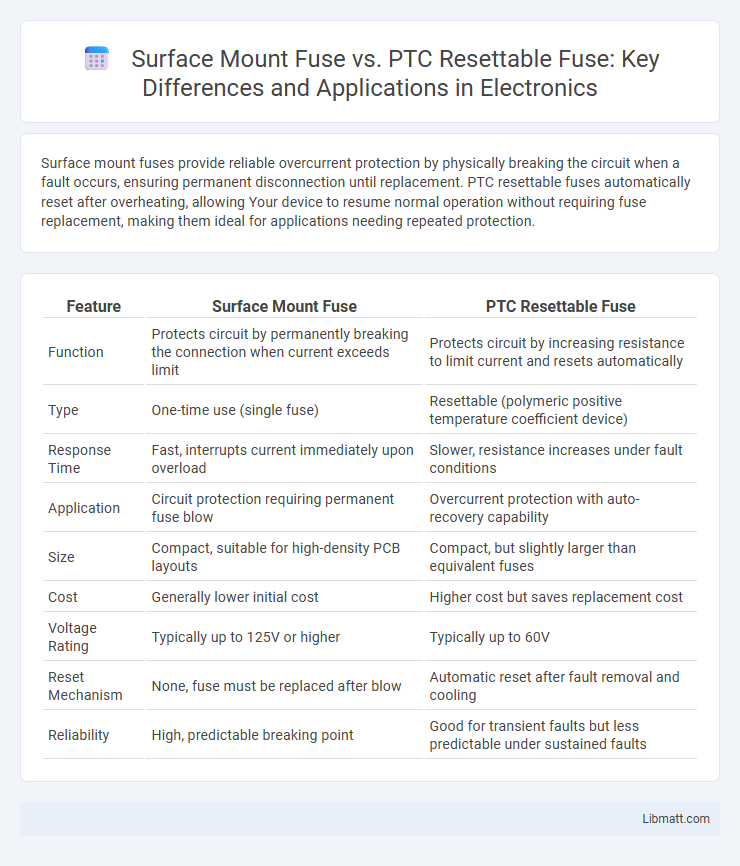Surface mount fuses provide reliable overcurrent protection by physically breaking the circuit when a fault occurs, ensuring permanent disconnection until replacement. PTC resettable fuses automatically reset after overheating, allowing Your device to resume normal operation without requiring fuse replacement, making them ideal for applications needing repeated protection.
Table of Comparison
| Feature | Surface Mount Fuse | PTC Resettable Fuse |
|---|---|---|
| Function | Protects circuit by permanently breaking the connection when current exceeds limit | Protects circuit by increasing resistance to limit current and resets automatically |
| Type | One-time use (single fuse) | Resettable (polymeric positive temperature coefficient device) |
| Response Time | Fast, interrupts current immediately upon overload | Slower, resistance increases under fault conditions |
| Application | Circuit protection requiring permanent fuse blow | Overcurrent protection with auto-recovery capability |
| Size | Compact, suitable for high-density PCB layouts | Compact, but slightly larger than equivalent fuses |
| Cost | Generally lower initial cost | Higher cost but saves replacement cost |
| Voltage Rating | Typically up to 125V or higher | Typically up to 60V |
| Reset Mechanism | None, fuse must be replaced after blow | Automatic reset after fault removal and cooling |
| Reliability | High, predictable breaking point | Good for transient faults but less predictable under sustained faults |
Introduction to Circuit Protection Devices
Surface mount fuses provide reliable circuit protection by physically breaking the circuit when overcurrent occurs, ensuring permanent disconnection to prevent damage. PTC resettable fuses, on the other hand, use a polymeric positive temperature coefficient material that increases resistance under fault conditions and automatically resets when cooled, offering reusable protection. Your choice between these devices depends on whether you need single-use or resettable overcurrent protection for sensitive electronic components.
Overview of Surface Mount Fuses
Surface mount fuses provide compact overcurrent protection directly on printed circuit boards, offering fast response times and precise current interruption in electronic devices. They are designed to protect sensitive components by breaking the circuit when excessive current flows, preventing damage and ensuring device reliability. Your choice of surface mount fuse impacts the overall safety and performance of high-tech electronics, especially in consumer gadgets and industrial applications.
Overview of PTC Resettable Fuses
PTC resettable fuses, also known as polymeric positive temperature coefficient (PPTC) devices, provide overcurrent protection by increasing resistance when excessive current flows through a circuit, thereby limiting current without permanently damaging the component. They automatically reset to their low-resistance state once the fault condition is removed and the device cools, making them reusable unlike one-time-use surface mount fuses. Their self-resetting capability enhances circuit reliability and reduces maintenance costs in applications such as consumer electronics, telecommunications, and automotive systems.
Key Differences Between Surface Mount and PTC Resettable Fuses
Surface mount fuses provide fast-acting overcurrent protection by physically breaking the circuit, ensuring complete disconnection when a fault occurs. PTC resettable fuses, also known as polymeric positive temperature coefficient devices, limit current by increasing resistance during fault conditions and automatically reset once normal temperature is restored. Your choice depends on whether you need a one-time fuse replacement or a reusable protection solution for repeated overcurrent events.
Advantages of Surface Mount Fuses
Surface mount fuses offer precise current protection with fast response times, making them ideal for safeguarding sensitive electronic components. Their compact size allows for high-density PCB layouts, enhancing device miniaturization without compromising reliability. You benefit from their stable performance under varying environmental conditions, ensuring consistent circuit protection in advanced electronics.
Advantages of PTC Resettable Fuses
PTC resettable fuses offer significant advantages over surface mount fuses, including automatic reset capabilities after overcurrent events, reducing the need for replacement and maintenance. Their polymer-based design provides reliable protection by increasing resistance when heated, safeguarding circuits without permanent damage. You benefit from enhanced device longevity and lowered downtime, making PTC resettable fuses a cost-effective choice in modern electronic applications.
Typical Applications of Surface Mount Fuses
Surface mount fuses are commonly used in consumer electronics, telecommunications equipment, and automotive circuits to provide overcurrent protection in compact spaces. They are ideal for safeguarding sensitive components such as LCD displays, microcontrollers, and power supplies due to their fast-acting characteristics and reliable interruption of fault currents. These fuses are also preferred in LED lighting and battery-powered devices where space efficiency and precise current limitation are critical.
Typical Applications of PTC Resettable Fuses
PTC resettable fuses are commonly used in consumer electronics, telecommunications equipment, and automotive circuits to provide overcurrent protection without the need for replacement after tripping. Their ability to automatically reset makes them ideal for safeguarding battery packs, power supplies, and USB interfaces from transient faults. These fuses are preferred in applications requiring reliable, reusable protection against short circuits and overloads.
Factors to Consider When Choosing Between Surface Mount and PTC Fuses
When choosing between surface mount fuses and PTC resettable fuses, consider factors such as current rating, response time, and physical size constraints to match your circuit requirements. Surface mount fuses provide fast, one-time overcurrent protection with precise blow characteristics, ideal for single-use applications. PTC resettable fuses offer self-resetting protection, making them suitable for devices needing repeated overcurrent cycling and space-saving solutions.
Conclusion: Selecting the Right Fuse for Your Design
Surface mount fuses provide precise, one-time overcurrent protection with fast response times, making them ideal for sensitive electronic components requiring guaranteed circuit interruption. PTC resettable fuses offer reusable overcurrent protection by increasing resistance during fault conditions and automatically resetting once normal current resumes, enhancing long-term device reliability without replacement. Choosing the right fuse depends on the specific application needs: use surface mount fuses for single-use, high-precision protection and PTC resettable fuses for cost-effective, maintenance-free current limiting in variable environments.
Surface Mount Fuse vs PTC Resettable Fuse Infographic

 libmatt.com
libmatt.com